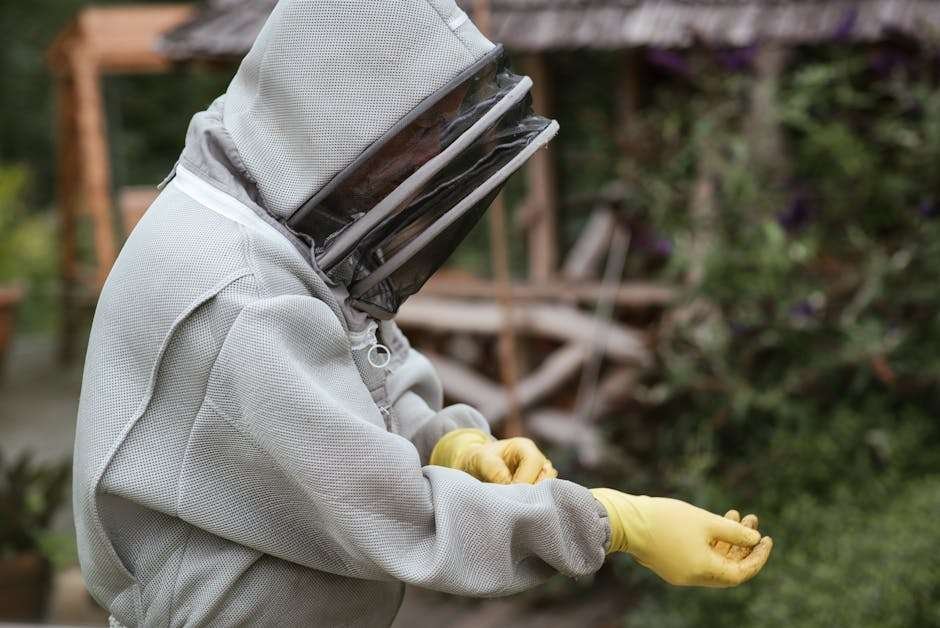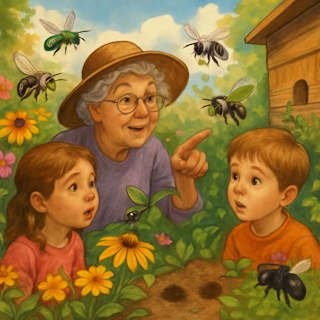A Beekeepers Adventure!
This short story reveals a young man’s first year of beekeeping
A Life Changing Moment
Marcus wiped the sweat from his brow as he stood before the white wooden boxes that would change his life forever. Three hives sat in the corner of his grandmother’s old orchard, looking deceptively peaceful in the morning sun.
At twenty-two, fresh out of college with a degree in environmental science and absolutely no idea what to do with his life, he had impulsively decided that beekeeping was his calling.
His grandmother’s property in rural Vermont seemed like the perfect place to start.

“Well, here goes nothing,” he muttered, pulling on the oversized bee suit he’d ordered online.
The previous week, he had attended a single beekeeping workshop at the local extension office, where a weathered farmer named Earl had made it sound simple enough.
“Bees pretty much take care of themselves,” Earl had said with a knowing smile that Marcus now realized held more wisdom than he’d understood at the time.
Spring: The Great Arrival
The bees arrived on a surprisingly warm April morning via a phone call from the post office.
“You need to come get your… um… buzzing packages right now,” the nervous postal clerk had stammered. Marcus raced into town, his heart pounding with equal parts excitement and terror.
The package bees came in screened wooden boxes about the size of a shoebox, each containing roughly 10,000 bees and a caged queen.
Marcus had practiced the installation process a dozen times in his head, but standing there with 30,000 living, buzzing insects was entirely different from watching YouTube videos.
His first hive installation went smoothly enough.
He removed the queen cage, checked that she was alive (a relief that made his knees weak), and placed her between the frames. The worker bees seemed to know what they were doing, even if he didn’t.
The second hive proved more challenging when he accidentally dropped the package, sending thousands of bees into an indignant cloud around his head.
Through the mesh of his veil, he watched in fascination as the bees gradually settled, following some invisible signal back to their new home.
The third hive nearly ended his beekeeping career before it began. As he lifted the queen cage, his sweaty fingers fumbled, and she fell into the grass.
For ten minutes that felt like hours, he crawled around on his hands and knees, searching for a tiny caged queen among the clover while her subjects buzzed ominously overhead.
Just as he was about to give up, he spotted the small wooden cage near a dandelion. The queen sat calmly inside, apparently unfazed by her adventure.
Early Summer: Learning the Language
By June, Marcus had begun to understand that beekeeping was less about controlling bees and more about learning to read their moods and needs. Each hive had developed its own personality.
Hive One was the steady worker, building comb with methodical precision.
Hive Two buzzed with aggressive energy, always quick to investigate any disturbance.
Hive Three seemed almost lazy in comparison, though Marcus suspected they were simply more efficient than he could comprehend.
His weekly inspections became a meditation of sorts.
The initial terror of opening a hive had given way to genuine fascination.
He learned to move slowly and deliberately, to watch for the subtle signs of a healthy colony: the pattern of capped brood cells indicating a productive queen, the delicate construction of new comb, the purposeful movement of forager bees returning heavy with nectar and pollen.
The first crisis came on a sweltering July afternoon.
Opening Hive Two for a routine inspection, Marcus found the bees in complete chaos. Instead of their usual organized bustle, they moved in agitated patterns, and a quick scan of the frames revealed the problem: no queen.
The distinctive cells where she should have been laying eggs were empty, and the workers’ behavior confirmed his worst fears.
Panic set in immediately. Without a queen, the colony would die within weeks.
Marcus called Earl, who listened patiently to his frantic explanation before chuckling.
“Son, sometimes they know better than we do. Check for queen cells – those long, peanut-shaped ones hanging off the comb.”
Sure enough, Marcus found several queen cells, indicating the bees had sensed their queen’s failing health and were raising replacements.
“Let them be,” Earl advised. “They’ve been doing this longer than humans have been keeping records.”
Mid-Summer: The Sweet Rewards
August brought the first honey harvest, and Marcus approached it with the reverence of a sacred ritual.
He had been checking the honey supers weekly, waiting for the moment when the bees would cap the cells with a thin layer of wax, indicating the honey’s perfect moisture content.
The extraction process was messier than he’d anticipated.
His kitchen looked like a crime scene, with sticky honey coating every surface despite his careful preparations.
But when he held up that first jar of golden honey to the light, watching the sun illuminate the amber liquid that his bees had created from the wildflowers, clover, and basswood trees around the property, he felt a profound connection to something ancient and essential.
He gave jars to neighbors, who exclaimed over the complex floral notes and the way it crystallized into perfect, creamy textures.
Mrs. Patterson from down the road declared it the best honey she’d tasted in fifty years.
Marcus beamed with pride, knowing that every drop represented countless flights by his bees, visiting millions of flowers across miles of countryside.
Late Summer: Unexpected Challenges
September brought the yellowjackets. Marcus first noticed them hanging around the hive entrances, and within days, they had become a serious threat.
These aggressive wasps were attempting to rob the weaker hives of their honey stores, and Hive Three was struggling to defend itself.
Marcus tried everything: reducing the hive entrances, setting wasp traps, even standing guard with a tennis racket during the worst attacks.
The sight of him flailing away at wasps while wearing his bee suit became a source of entertainment for his neighbors, though none dared get close enough to offer help.
The solution came from an unexpected source.
His eight-year-old niece, visiting for the weekend, watched him battle the yellowjackets and innocently asked, “Why don’t you just move their food somewhere else?”
Inspired, Marcus set up feeding stations filled with sugar water far from the hives.
The yellowjackets, apparently preferring easy sugar to the effort of robbing honey, redirected their attention to the feeders.
Autumn: Preparing for Winter
October meant preparing the hives for Vermont’s harsh winter. Marcus had read about winterization extensively, but the reality of condensing three thriving colonies into smaller spaces felt counterintuitive.
He removed the empty honey supers, combined weak hives with stronger ones, and wrapped the hive bodies in black tar paper to help absorb solar heat.
The hardest part was feeding.
The bees needed enough stores to survive months without foraging, and Marcus spent evenings in his kitchen preparing sugar syrup, feeling like he was cooking for an enormous extended family.
Each hive required different amounts;
Hive One, now his strongest colony, barely needed supplemental feeding, while the combined hive required constant attention to build up adequate stores.
As the temperatures dropped, Marcus found himself checking on the hives daily, looking for signs of activity on warm afternoons when the bees might take cleansing flights.
The silence of the winter-prepared hives felt ominous after months of constant buzzing, but Earl assured him this was normal.
“They’re not dead,” the old farmer explained, “they’re just waiting.”
Winter: The Long Quiet
December through February stretched endlessly.
Marcus read every beekeeping book he could find, watched documentaries about pollinators, and planned improvements for the coming season.
He built additional hive bodies in his garage, painted equipment, and designed a more efficient honey extraction setup.
The hardest part was not knowing. Unlike other livestock, bees couldn’t be checked regularly during winter.
Opening a hive on a cold day could kill the cluster, so Marcus was left to hope and trust that his autumn preparations had been adequate.
On warm days when the temperature climbed above forty degrees, he would walk out to the hives and listen carefully, hoping to hear the reassuring hum of active bees inside.
February brought a scare when he noticed dead bees scattered in the snow around Hive Three.
His heart sank as he imagined opening empty boxes come spring, but a call to Earl provided perspective.
“Dead bees outside means live bees inside,” the farmer explained.
“They’re housekeeping, dragging out the winter casualties. It’s actually a good sign.”
Spring Return: Full Circle
March arrived with the first warm days, and Marcus approached his hives with the nervous anticipation of a new parent checking on sleeping children.
Hive One buzzed with healthy activity, bees flying in and out with obvious purpose.
Hive Two, the combined colony, showed good traffic as well.
But Hive Three remained ominously quiet.
His first spring inspection confirmed his fears.
Hive Three had died sometime in January, the cluster having dwindled too small to maintain warmth.
Marcus found the dead bees still clustered together, surrounded by ample honey stores.
The sight broke his heart, but Earl’s wisdom helped him process the loss.
“Part of beekeeping is accepting that you can’t save them all. But you learned something that will help you save the next one.”
The surviving hives thrived as spring progressed.
Marcus split the strongest colony to create a replacement for the lost hive, watching in amazement as the bees raised a new queen and established themselves as confidently as if they’d been planning it all along.
Lessons Learned
As Marcus stood in his orchard one year later, preparing packages for his fourth and fifth hives, he reflected on the journey.
The young man who had nervously installed his first bees seemed like a stranger now.
He had learned to read the subtle signs of hive health, to move with confidence among thousands of stinging insects, and to work in partnership with creatures whose ancient wisdom often surpassed his book knowledge.
The honey harvest that second August yielded twice as much as his first attempt, but more importantly, Marcus had found something he hadn’t known he was searching for.
In tending his bees, he had discovered patience, observation skills, and a deep connection to the rhythms of the natural world.
The bees had taught him that some of life’s most important lessons come not from controlling outcomes, but from learning to work within natural systems.
His grandmother’s orchard hummed with new life, and Marcus smiled as he watched his forager bees returning heavy with the first nectar of another season.
This adventure was far from over.



